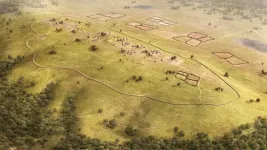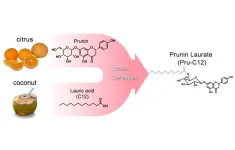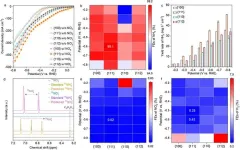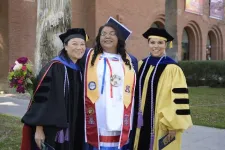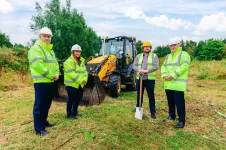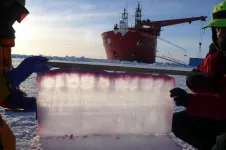(Press-News.org) [Vienna, August 26 2024] – Since the end of the last Ice Age, growth of human population was far from uniform, marked instead by periods of rapid expansion followed by sharp declines. The reasons behind these fluctuations remain only partially understood. Previous research by CSH scientists Peter Turchin, Daniel Kondor, and an international team of collaborators, demonstrated that social conflicts, rather than – or in addition to – environmental factors, could have significantly impacted these patterns. Now, they add another piece to the puzzle.
Wars and conflicts not only cause direct casualties but also create an atmosphere of distress and fear. This fear, by affecting where and how people settle, could have influenced substantially how the population in Europe developed, as shown in a study published in the Journal of the Royal Society Interface.
Flight And Overpopulation
“Globally, scientists have extensively studied and debated the presence and role of conflicts in prehistory. However, estimating their effects, such as those on population numbers is still difficult,” explains Daniel Kondor from CSH. “This is even more complicated by potential indirect effects, like people who, out of fear, leave their homes or avoid certain areas.”
These indirect impacts of conflict could have caused significant, long-term population fluctuations in non-state societies, such as in Neolithic Europe (circa 7,000 BC to 3,000 BC), according to the study’s findings. “Our model shows that fear of conflict led to population declines in potentially dangerous areas. As a result, people concentrated in safer locations, such as hilltops, where overpopulation could lead to higher mortality and lower fertility,” Kondor explains.
Match Archaeological Evidence
The ongoing threat would prevent the settlement of much of the remaining land. Co-author Detlef Gronenborn from the Leibniz Centre for Archaeology (LEIZA) in Mainz, Germany, adds: “The results from the simulation studies nicely match empirical evidence from archaeological field work, like for instance the Late Neolithic site of Kapellenberg near Frankfurt, dating to around 3700 BCE. Like there, we have many instances of a temporal abandonment of open agricultural land, associated with a retreat of groups to well-defendable locations and considerable investments in large-scale defense systems like ramparts, palisades and ditches.”
“This concentration of people in specific, often well-defended locations could have led to increasing wealth disparities and political structures that justified these differences,” adds Peter Turchin from CSH. “In that way, indirect effects of conflict might have also played a crucial role in the emergence of larger political units and the rise of early states.”
Complexity Science Meets Archaeology
To simulate population dynamics in Neolithic Europe, the researchers developed a computational model. To test the model, they utilized a database of archaeological sites, analyzing the number of radiocarbon age-measurements from various locations and time periods, under the assumption that this reflects the scale of human activities, and thus, ultimately, population numbers. “This allows us to examine the typical amplitudes and timescales of population growth and decline across Europe,” Kondor explains. “Our goal was for our simulation to reflect these patterns.”
In the future, the model could help interpret archaeological evidence, such as signs of overpopulation or land use patterns, which in turn can provide necessary context and data for further refinements to modeling. This is a typical example of interdisciplinary collaboration that CSH aims to foster. “Using complexity science methods, we develop mathematical models to analyze the rise and fall of complex societies and identify common factors,” Turchin explains. This involves collecting vast amounts of historical data, managed in specialized databases like the Seshat Global History Databank. “For the most complete picture possible, direct collaboration with archaeologists is immensely important. This study is a great example of the potential that such interdisciplinary collaboration can have,” Kondor emphasizes.
About CSH
The Complexity Science Hub (CSH) is Europe’s research center for the study of complex systems. We derive meaning from data from a range of disciplines – economics, medicine, ecology, and the social sciences – as a basis for actionable solutions for a better world. Established in 2015, we have grown to over 70 researchers, driven by the increasing demand to gain a genuine understanding of the networks that underlie society, from healthcare to supply chains. Through our complexity science approaches linking physics, mathematics, and computational modeling with data and network science, we develop the capacity to address today’s and tomorrow’s challenges.
END
What role did fear play in Europe's population growth?
Fear of conflict may have influenced the development of prehistoric European societies as much as the conflicts themselves, according to a recent study by the Complexity Science Hub (CSH)
2024-08-28
ELSE PRESS RELEASES FROM THIS DATE:
Shot of confidence: Building trust in vaccination programs
2024-08-28
A new paper in the Journal of Public Health, published by Oxford University Press, finds that highlighting the harms of not getting vaccinated is a more effective message than emphasizing the benefits of vaccination for individual patients or the benefits to public health.
Vaccination remains the most economical and effective public health strategy for reducing morbidity and mortality. But some vaccines, such as those for flu, pneumonia and HPV, are given voluntarily. Often due to misinformation or ignorance many people are reluctant to get vaccinated for various diseases (or to vaccinate their children). For years researchers have been investigating various strategies ...
Protect your teeth with fruit: antimicrobial effects found in biomass compounds
2024-08-28
Periodontal disease is an inflammatory disease caused by a periodontal pathogenic bacteria infection that affects oral and internal health. Good oral care is essential for prevention, but most over-the-counter oral hygiene products are disinfectants that can be highly irritating. This makes them unsuitable for use by young children and the elderly, who are susceptible to periodontal disease.
To find an antibacterial that is easy to use and effective in preventing periodontal disease at all ages, Professor Shigeki Kamitani of Osaka Metropolitan University’s Graduate School of Human Life and Ecology led a research team in verifying the antibacterial effect of seven ...
AI tools like ChatGPT popular among students who struggle with concentration and attention
2024-08-28
Since their release, AI tools like ChatGPT have had a huge impact on content creation. In schools and universities, a debate about whether these tools should be allowed or prohibited is ongoing.
Now, researchers in Sweden have investigated the relationship between adolescents’ EF and their use and perceived usefulness of generative AI chatbots for schoolwork. They published their results in Frontiers in Artificial Intelligence.
“Students with more EF challenges found these tools particularly useful, especially for completing assignments,” said Johan Klarin, a school psychologist and research assistant at the Department of Psychology ...
Insights into spinel cobalt oxides may lead to efficient ammonia synthesis
2024-08-28
Researchers have made a significant breakthrough in the development of catalysts for the electrochemical nitrate reduction reaction (eNO₃RR) to ammonia, a process that has broad implications for sustainable energy, agriculture, and industrial applications.
Ammonia, a critical component in global food production, also holds promise as a zero-carbon fuel due to its high energy density, clean combustion products, and established infrastructure for storage and transportation. However, the current method of producing ...
U of A College of Nursing receives $1.6M grant to support Indigenous students
2024-08-28
Indigenous students pursuing nursing careers at the University of Arizona College of Nursing will benefit from additional financial support thanks to a $1.6 million grant from the U.S. Department of Health and Human Services’ Indian Health Service.
The grant will fund the successful Indians in Nursing: Career Advancement and Transition Scholars, or INCATS, program for another five years. The program provides Indigenous students at the U of A College of Nursing with financial support for tuition, fees and a living stipend.
Additionally, the grant provides resources for dedicated time and personnel to partner with tribal ...
Moths may use disco gene to regulate day/night cycles
2024-08-28
How does one species become two? If you’re a biologist, that’s a loaded question. The consensus is that, in most cases, the process of speciation occurs when individuals from a single population become geographically isolated. If they remain separate long enough, they lose the ability to interbreed.
A new study published in the journal Proceedings of the Royal Society B: Biological Sciences demonstrates what happens when a less common form of speciation occurs. Rather than being separated by a physical barrier, such as a mountain range or an ocean, members of a species can become ...
Henna secures $30,000 from PSU’s University Venture Development Fund to enhance AI fairness & safety
2024-08-28
UVDF Funding, Henna
Henna Secures $30,000 from PSU’s University Venture Development Fund to Enhance AI Fairness & Safety
Portland, OR – August 13, 2024 – Henna, a startup with deep ties to Portland State University (PSU), has successfully secured $30,000 in funding from the University Venture Development Fund (UVDF). This grant will support Henna's mission to make AI adoption fairer and safer.
Henna was founded earlier this year by Arsh Haque (they/them), Chair of the Diversity, Equity, & Inclusion ...
Heriot-Watt University breaks ground on new £2.5M Optical Ground Station
2024-08-28
Work has started on a new Quantum Communications Hub Optical Ground Station (HOGS), a state-of-the-art telescope which is being built on Heriot-Watt University’s Research Park.
The new facility will demonstrate and test satellite quantum secure communications, maintaining and growing the UK’s strength in the field of quantum technologies. It is scheduled to be fully operational by late Autumn [2024].
As well as helping to tackle future cyberattacks by researching methods to send secure transmissions via satellites, it will unlock new research on space environmentalism alongside innovative R&D activities for future laser communication ...
SUNY Board of Trustees and Chancellor King announce presidential appointment at SUNY College of Optometry
2024-08-28
New York, NY – The State University of New York Board of Trustees today appointed Dr. David Troilo as president of SUNY College of Optometry. He is the 4th president to serve the state’s only college of optometry, following the retirement of Dr. David A. Heath after 17 years of dedicated service to the campus. Dr. Troilo’s appointment is effective immediately.
The SUNY Board of Trustees said, “SUNY College of Optometry is a center of research and academic excellence, and Dr. Troilo is a collaborative and thoughtful leader who is ready to move the campus forward growing ...
Cold math, hot topic: Sea ice thermal conductivity
2024-08-28
A new applied mathematical theory could enhance our understanding of how sea ice affects global climate, potentially improving the accuracy of climate predictions.
The authors of a new paper published in the Proceedings of the Royal Society A on 28 August, offer new insights into how heat travels through sea ice, a crucial factor in regulating Earth's polar climate.
Dr Noa Kraitzman, Senior Lecturer in Applied Mathematics at Macquarie University and lead author of the study, says the research addresses a key gap in current climate modelling.
“Sea ice covers about 15 per cent of the ocean’s surface during ...
LAST 30 PRESS RELEASES:
Sleeping in on weekends may help boost teens’ mental health
Study: Teens use cellphones for an hour a day at school
After more than two years of war, Palestinian children are hungry, denied education and “like the living dead”
The untold story of life with Prader-Willi syndrome - according to the siblings who live it
How the parasite that ‘gave up sex’ found more hosts – and why its victory won’t last
When is it time to jump? The boiling frog problem of AI use in physics education
Twitter data reveals partisan divide in understanding why pollen season's getting worse
AI is quick but risky for updating old software
Revolutionizing biosecurity: new multi-omics framework to transform invasive species management
From ancient herb to modern medicine: new review unveils the multi-targeted healing potential of Borago officinalis
Building a global scientific community: Biological Diversity Journal announces dual recruitment of Editorial Board and Youth Editorial Board members
Microbes that break down antibiotics help protect ecosystems under drug pollution
Smart biochar that remembers pollutants offers a new way to clean water and recycle biomass
Rice genes matter more than domestication in shaping plant microbiomes
Ticking time bomb: Some farmers report as many as 70 tick encounters over a 6-month period
Turning garden and crop waste into plastics
Scientists discover ‘platypus galaxies’ in the early universe
Seeing thyroid cancer in a new light: when AI meets label-free imaging in the operating room
Neutrophil-to-lymphocyte ratio may aid risk stratification in depressive disorder
2026 Seismological Society of America Annual Meeting
AI-powered ECG analysis offers promising path for early detection of chronic obstructive pulmonary disease, says Mount Sinai researchers
GIMM uncovers flaws in lab-grown heart cells and paves the way for improved treatments
Cracking the evolutionary code of sleep
Medications could help the aging brain cope with surgery, memory impairment
Back pain linked to worse sleep years later in men over 65, according to study
CDC urges ‘shared decision-making’ on some childhood vaccines; many unclear about what that means
New research finds that an ‘equal treatment’ approach to economic opportunity advertising can backfire
Researchers create shape-shifting, self-navigating microparticles
Science army mobilizes to map US soil microbiome
Researchers develop new tools to turn grain crops into biosensors
[Press-News.org] What role did fear play in Europe's population growth?Fear of conflict may have influenced the development of prehistoric European societies as much as the conflicts themselves, according to a recent study by the Complexity Science Hub (CSH)
